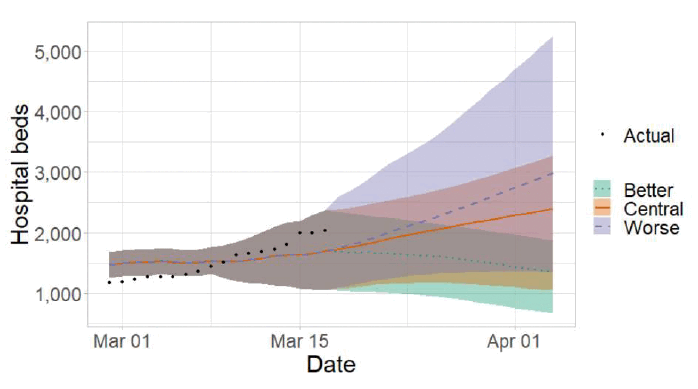Coronavirus (COVID-19): state of the epidemic - 18 March 2022
This report brings together the different sources of evidence and data about the Covid epidemic to summarise the current situation, why we are at that place, and what is likely to happen next.
This document is part of a collection
Looking ahead
Scottish Contact Survey
Changes in patterns of mixing and adherence to restrictions will impact on future case numbers. The Scottish Contact Survey measures times and settings that people mix where they could potentially spread Covid-19. Average contacts from the most recent Panel A cohort of the Scottish Contact Survey (week ending 9 March) indicate an average of 4.8 contacts.
Mean contacts within the work and other setting (contacts outside home, school and work) have increased within the last two weeks by 18% and 36% respectively. Contacts within the home have decreased by 5% levels over the same period. Individuals within the youngest age groups (18-59) have all reported a rise in contacts within the last two weeks, with the 18-29 age group increasing by approximately 55%. Increases are largely driven by a rise in contacts in the work and other setting (contacts outside home, school and work). Those within the oldest age groups (60+) have decreased their contacts in the last two weeks.
Modelling the Epidemic
The latest Modelling the Epidemic report includes projections over the next three weeks for new daily infections in Scotland. These projections include the effect of booster take up. The 'Central' scenario assumes that transmissibility remains at current levels. 'Worse' assumes a higher transmissibility for Covid-19, whereas 'Better' assumes a lower transmissibility. These projections do not include the changes to restrictions announced on 15 March 2022. It is estimated that daily infections may be up to 49,000 in early April. However, the future trajectory of infections is uncertain[69].
Figure 14 shows the impact of the daily infection projections on the number of people in hospital. The modelling includes all hospital stays, whereas the actuals only include stays up to 28 days' duration that are linked to Covid-19. There continues to be uncertainty over hospital occupancy in the next three weeks.

Long Covid
According to the Office for National Statistic (ONS), long Covid is defined as symptoms persisting more than four weeks after the first suspected coronavirus (Covid-19) episode that are not explained by something else.
Estimates of the proportion of people in the private residential population in Scotland that experience long Covid symptoms are published by the ONS Covid-19 Infection Survey on a monthly basis. The next scheduled release of long Covid data from the Covid-19 Infection Survey is expected to be summarised in this report on 8 April. For information on the most recent estimates, see the State of the Epidemic report published on 4 March 2022.
Weekly modelled estimates for Scotland are also usually published in the Modelling the Epidemic report, which can be found here. However, a report on the rate of long Covid-19 has not been included this week. This will resume again once updated estimates of self-reported long Covid-19 prevalence amongst those infected with the less severe Omicron variant become available.
Contact
There is a problem
Thanks for your feedback